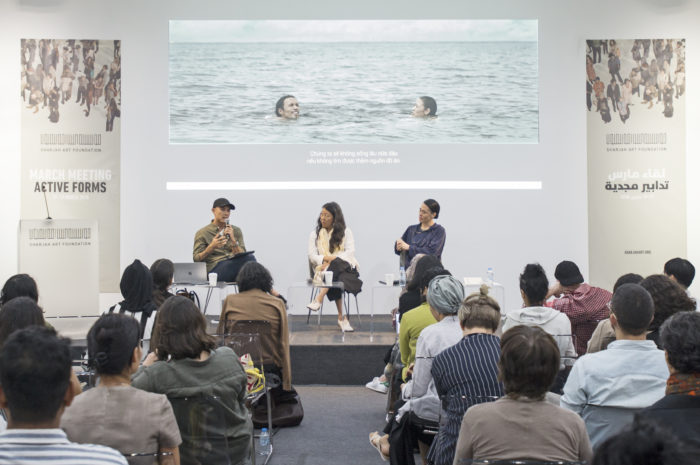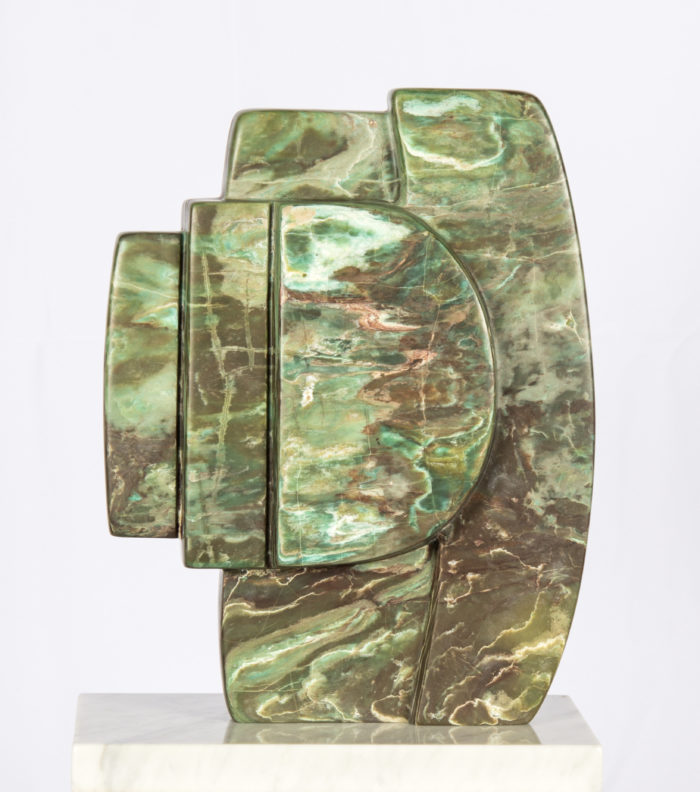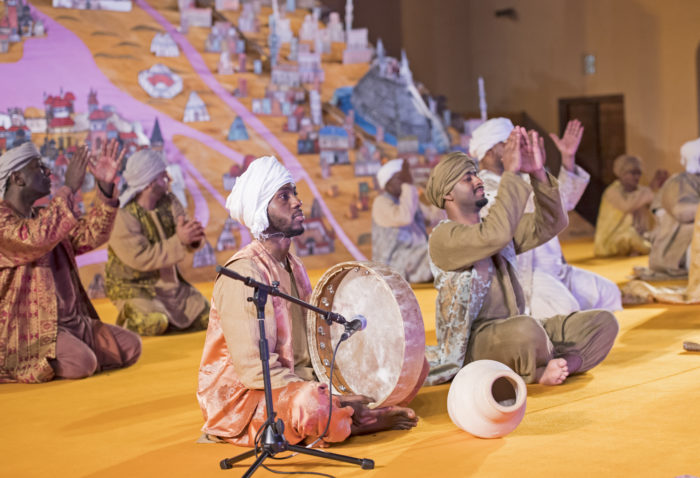
Every March, the seaside city of Sharjah in the United Arab Emirates, becomes a welcome reprieve from the frenzied international art fair circuit. Juxtaposed by its commercial leaning neighbor, Art Dubai, Sharjah Art Foundation’s March Meeting (March 17-19) offers an immersive three day gathering that offers time and space to examining practices in art, performance, writing, film and architecture, and how these cultural tools can advance this year’s thematic framework: resistance.
During March meeting, the sprawling campus of SAF continues to host more permanent exhibitions. This year’s line-up included a diverse group of artists working in the region, along with “Active Forms,” a collection show expanding on flurry of ideas posed in annual meet (on view March 16-June 16). Cultured traveled to Sharjah to revel in the crush.

Revelatory Panelists (and Audience Members) It’s poetic to the zeitgeist of March Meeting, that an absent artist from a panel conducted by Eungie Joo of San Francisco MoMA, would prompt the curator to pluck two of the foremost filmmakers engaging with identity today from the audience- Los Angeles based Wu Tsang, recently featured the New Museum’s “Trigger” show, and 2018 recipient of prestigious Hugo Boss Prize, along with past Whitney Biennial participant, and filmmaker of “The Island” (2017), Tuan Andrew Nguyen.
Outside this spontaneous assemblage, panels such as “Terms of Order,” a talk between Naeem Mohaiemen, Dale Harding and Marwa Arsanios, which broached the question of how to locate oneself, specifically within the wall of institutions that has historically disempowered the panelists. Harding, a Brisbane born artist of aboriginal descent, enraptured the March Meeting crowd, with his meditations on the alienation of institutional participation and the moments of tangible progress that come through this struggle.
For example, works such as “Composite Wall Panel: Reckitt’s Blue” (2017) a silk screen mural of a lapis hue in last year’s Documenta 14, invited a form of regressive talk familiar to Harding. “I overheard people talking and judging that ‘this cannot possibly be the work of an aboriginal person, because he uses blue,’” insisting that Harding should only use the pigmentation associated with aboriginal people.
Yet through incorporating family members to work by Harding’s side during installation, the artist describes a tangible shift. Harding recalls his cousin-brother saying the gallery walls “felt like home” after utilizing traditional materials to create Harding’s murals. “By thinking through the contemporary art practice between us, we shared a ‘meaning and doing’ of our culture within the institutional walls,” Harding concluded, to a rousing applause.
A Female-Centric Survey of the Region Of the five career surveys installed at Sharjah Art Foundation alongside March Meeting, three are by female artists with drastically different practices, providing a complex tapestry of women working in the region.
In collaboration with the Sharjah Art Museum, sculptor Mona Saudi’s show “Poetry and Form” delves into the work of the Jordanian born artist, spanning from 1963-2017. Saudi, 72, a woman with a shamanic air, is riddled with one liners that can convert us all to the language of stone, a native tongue to artist. This is largely in part to Saudi prioritizing local materials filled with the character of the regions where the stone is found. For example, a suite of sculptures including “Growth” (2002), derives from the Jordanian marble from Saudi’s hometown, adding to the stone’s already rich character, with tritone hues of chocolate brown and pops of emerald green.

“I realize my dreams,” Saudi says during a tour of show, “When I first saw this museum in 1997, I said to myself, I want to see my sculptures in this museum, and that day has come.”
Across from the museum, in the heritage house of Bait Al Serkal, is four decade-spanning retrospective of Egyptian born Anna Boghiguian, 71. Expelled from Cairo in her youth, Boghiguian’s practice takes on a more overtly political tone, probing migration, and trails of human suffering that play out insidiously beside seemingly innocuous sources. This frames Boghiguian’s perhaps most successful work, “The Salt Traders” (2015) an installation snaking around almost the entire second level of the former Emirati homestead, pulling from all elements of artists practice, including drawing, collage, and assemblage, as it cuts through the tentacle-like reach of salt trade through the centuries.
Finally, the price of salt becomes the price of sugar in Zineb Sedira’s “Air Affairs and Maritime Nonsense.” The French Algerian artist, 54, known most notably for her film and video work probing family dynamics, communication, and gender amidst migration and diaspora, also takes on the thematic interest of Boghiguian. Works like photo series “Sugar Silo I & II” (2013) and “Seafaring” (2013) contemplate the small and large scale implications of the sugar trade.
Also of note are the two new commissioned works for her survey with SAF, “Sunken Stories” (2018) and “Air Affairs,” (2018) both works that utilizing the city of Sharjah a launching point to trace colonial reach within sea and air trade routes.

Performances of Resistance With storytelling acumen to rival Scheherazade herself, Egyptian artist Wael Shawky reconstructed the eleventh century epic poem, “La Chanson de Roland” (The Song of Roland), for audience of a few hundred in the Foundation’s outdoor Calligraphy Square. Shawky’s conception is ripe with pageantry and twists, with twenty performers native to the Gulf singing an Arabic translation of “Roland” in the fidjeri tradition, against a lush backdrop aping medieval maps of regional cities, such as Aleppo and Istanbul.
To the Meeting’s theme of resistance as well- itis not lost on Shawky that the subject of “Roland” celebrates the domination of the Saracens (a historically pejorative term for Muslim Arabs), and by weaving the two cultures, the conversations becomes a call and response, rather than stratified story of power.
In sonic experience of a different kind, Hajra Waheed’s dreamy performance, “Hold Everything Dear,” begins with the Montreal-based artist sitting with a light box, projecting an unidentifiable mass onto a large screen. The curious projection easily passes for the head of Grecian statue, like a petrified character on an ancient urn, updated for the internet age. The video goes on, and it's not a statue, but a squashed paper bag that becomes poked, prodded, and even caressed by Waheed’s phantom hands below. It's thrilling to watch the blob continue to transform as Waheed relays a poem in an ASMR-esque tone, it's content spanning the sensation of exile, to sadomasochism. “Say it, I am a barbarian,” the artist’s haunting, erotic words, plea.




